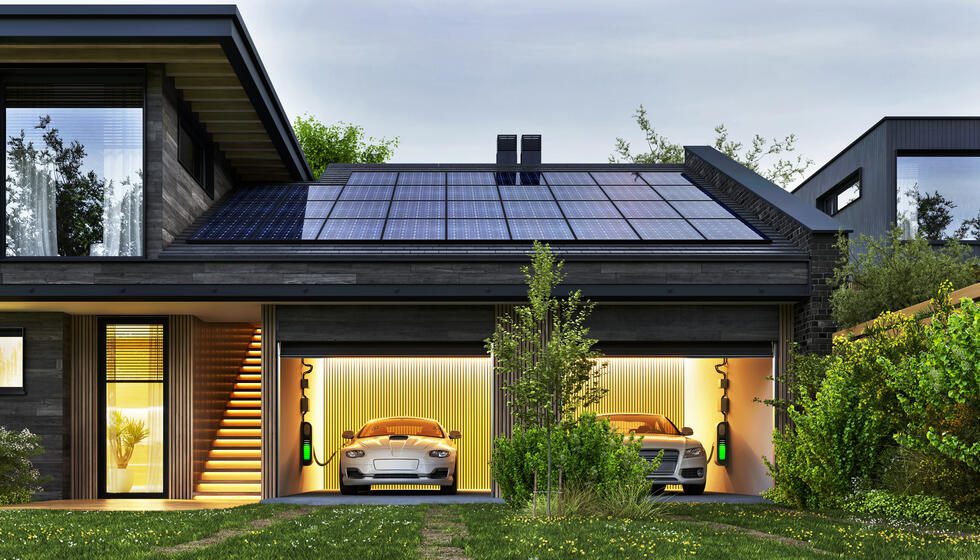Some of my fondest childhood memories are of power outages. We played board games by candlelight and made shadows with flashlights in our makeshift blanket tents. Like now, we depended heavily on electricity, but our flickering candles during summer storms were the perfect backdrop to the rain.
But, today, we face more frequent and extreme climate events, energy insecurity, and cybersecurity threats – part of a long list of megatrends that make the move to sustainability and electrification of our homes more urgent than ever. The goal now is to transition everything to clean electricity, make our homes smarter, and strive toward net zero. That’s where home electrification comes in.

What is home electrification?
Home electrification refers to the process of switching from fossil fuels to electricity to meet your home’s power needs. This includes anything from heating, cooling, and water heating to cooking, laundry, and just about any other appliance that requires power. Electricity is a more sustainable choice because it can be generated from clean, renewable sources like solar and wind. It is also the most efficient energy source. When you combine it with smart technology, it can become even more efficient.
Home electrification is a major step towards this sustainable future. It reduces our carbon emissions and reliance on imported fossil fuels and helps us save money on energy bills. Using existing technologies, we can cut up to 80% of residential emissions. So how does a homeowner get started?
Beginning the home electrification journey
Electrifying your home may seem complex and a little daunting at first glance. First, many see these projects as unaffordable. Many also don’t know where to start and in what order to purchase and install things like solar panels, heat pumps, electric vehicles and chargers, energy storage, and more.
Finally, once they decide to move forward, they don’t know how to find the right products and installers. EnergySage can help with that. EnergySage allows you to receive and compare multiple quotes for renewable solutions from vetted installers in your area.
Confronting cost concerns and debunking the myths
Historically, the perceived cost has been a deterrent to adopting home electrification products like solar – either because it is more expensive than anticipated, unaffordable, or the return on investment isn’t worth it.
But here are a few counterarguments:
- Electricity costs roughly $35k over 20 years, so a $20k solar panel system that offsets a $100/month bill is a wise investment.
- By switching to electric machines (how we power our cars, heat our air and water, cook our food, dry our clothes and get our energy), families save an average of $1,800 per year on their energy bills
- Electrifying space and water heating can save the average home $516 in energy costs
- Solar increases home value by 4%, worth around $14k for the median US home value, even if only living there for five years.
- Solar costs have been cut in half twice over the last two decades. In the early 2000s, residential solar installation cost was over $11/watt; by 2010, it was $6.20/watt. Today, pricing is under $3/watt. So, for $30k, you can buy the same system now that would’ve cost $60k in 2010 or a whopping $100k in 2000.
Even with these savings, many households still find these improvements unaffordable. But the US Inflation Reduction Act (IRA) aims to make sustainability upgrades accessible to everyone. In fact, the 53M low and moderate income households in America would be eligible for an average of over $10,000 in home electrification rebates. For example, they can receive a rebate up to $1400 for an energy-efficient heat pump water heater and up to $4,000 for a new electrical panel. Residential solar and storage installations are eligible for a 30 percent tax credit, and an EV charger is eligible for up to 30 percent credit of its cost. All these incentives add up, helping to put these improvements within the financial reach of many homeowners.
What equipment should I install first?
According to EnergySage, smart thermostats are consumers’ number one electrification “gateway” purchase. They’re cost-efficient, unobtrusive, easy to install, and provide enough insights to convince people to do more. In fact, 91% of people who start their journey with smart thermostats make upgrades like solar installations, heat pumps, and more.
The second main entry to home electrification can be found in the garage. If you purchase an electric vehicle (EV), you will want to consider a Level 2 EV charger for your home. It is less expensive and more convenient than using charging networks. Plus, it’s faster and more efficient than simply plugging into an outlet or using an L1 charger.
Solar installation often becomes the next practical investment for EV owners – in fact, half of the people who start their electrification journeys with EVs make solar their next step. And CleanTechnica found in a survey that 38% of EV drivers in North America had solar panels on their homes. When compared to just 8% of U.S. homeowners who currently have residential solar, there is a clear link between owning an electric car and generating solar energy.” This is because they become more aware of their energy usage and don’t just want to replace the cost at the pump with higher electrical bills.
How do I get started?
It’s important to do your research – there are several online resources and tools to help you make confident and informed decisions as you explore home electrification, including EnergySage. Then, when you’re ready, we can help you pick the solution that’s right for you and provide estimates and trained installers.
Home electrification opens a wide world of possibilities. Incorporating renewable, efficient technologies provides remarkable control over your energy consumption. This newfound flexibility allows you to make sustainable choices and enjoy the benefits of a reliable and efficient energy system. Are you ready to start your journey toward a greener and smarter future?





Conversation
Very informative.